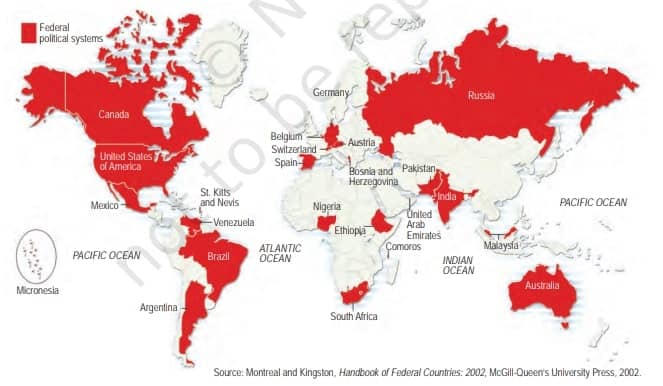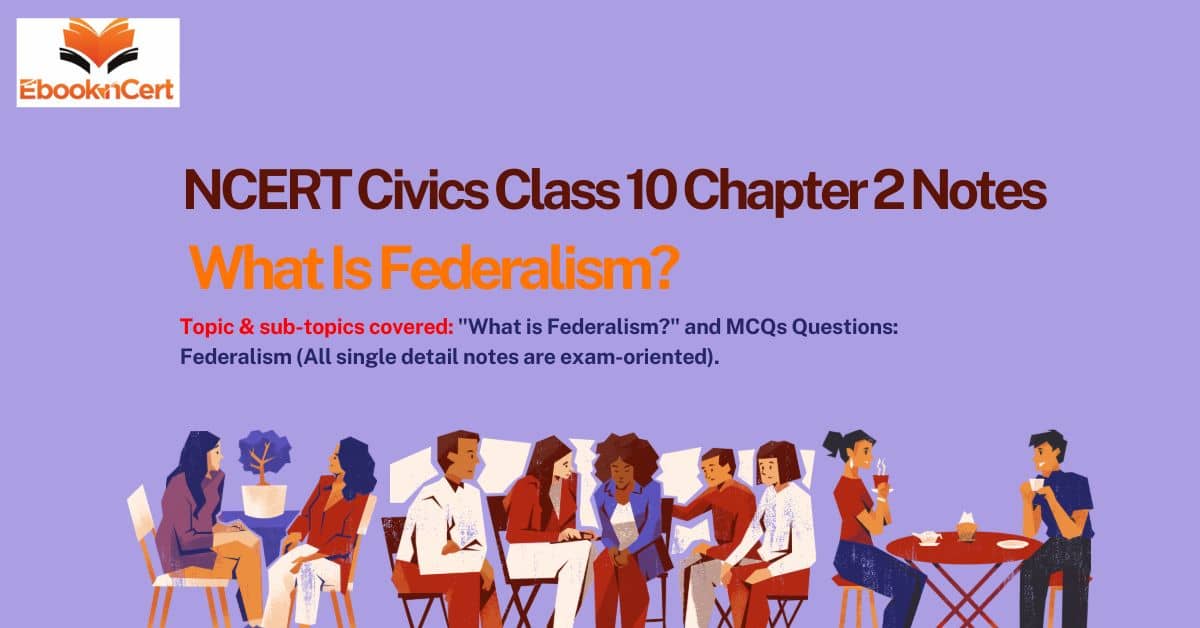NCERT Political Science (Civics) Class 10 Chapter 2 | What Is Federalism?
Topic & sub-topics covered: “What is Federalism?” and MCQs Questions: Federalism (All single detail notes are exam-oriented).
We have discussed in-depth and exam-oriented pointers that can be asked in the board exam of class 10th about “What is Federalism?” from the NCERT Political Science (Civics) notes for class 10th chapter 2 “Federalism“.
Download the NCERT Political Science (Civics) for Class 10 Chapter 2 Federalism PDF Notes
NCERT Civics (Political Science) Class 10th Chapter 2 – Federalism Notes & MCQ’s Question-Answer
Explore the key concept of federalism in Chapter 2 of Class 10 Civics (Political Science). This chapter discusses power-sharing between the central government and states in India, highlighting its role in maintaining unity and promoting regional autonomy, What is Federalism?, What Makes India a Federal Country?, How is Federalism Practised?, Decentralisation in India. Understand Indian federalism’s theory, practices, and its newest tier – local government. These CBSE/NCERT notes simplify the topic with clear explanations and with the help of examples. Make your understanding of democracy and governance strong with comprehensive notes on federalism’s structure and significance.
Introduction to Federalism and Power Sharing

1. Vertical Division of Power:
- Refers to the division of power among different levels of government.
- Recognized as one of the major forms of power-sharing in modern democracies.
2. Definition of Federalism:
- A system of government where power is shared between central, state, and local governments.
Focus of the Chapter
1. Understanding Federalism:
- General description of federalism as a system of governance.
- Examines how federalism operates in theory and practice in India.
2. Federal Constitutional Provisions:
- Analysis of constitutional features that establish and govern federalism in India.
3. Strengthening Federalism:
- Discussion on policies and politics that have reinforced federalism in practice.
4. Local Government as a Third Tier:
- Exploration of the emergence and significance of the local government in Indian federalism.
- Represents a new tier, extending federalism to the grassroots level.
What is Federalism?
Comparison Between Belgium and Sri Lanka
1. Belgium’s Transition to Federalism:
- Shifted from a unitary to a federal form of government in 1993.
- Regional governments were given constitutional powers, independent of the central government.
2. Sri Lanka’s Unitary System:
- The national government retains all powers.
- Tamil leaders demand a federal system to accommodate regional aspirations.
Definition of Federalism | What is Federalism?
1. Federal System of Government:
- Power is divided between a central authority and various constituent units.
- Usually involves two levels:
a. A national government responsible for common interests.
b. State or provincial governments are responsible for local administration.
2. Contrast Between Federal and Unitary Systems:
- In federal systems, the central government cannot dictate state governments.
- State governments are independent and answerable directly to the people.
- In unitary systems, sub-units are subordinate to the central government.
Key Features of Federalism
1. Multiple Levels of Government:
- Two or more tiers govern the same citizens, each with its jurisdiction.
2. Constitutionally Guaranteed Powers:
- Jurisdictions of all levels are specified in the constitution.
- Fundamental provisions require consent from all levels for amendments.
3. Judicial Interpretation:
- Courts, particularly the highest court, interpret the Constitution and resolve disputes between levels of government.
4. Financial Autonomy:
- Revenue sources for each level are specified to maintain independence.
5. Dual Objectives:
- Federalism aims to:
a. Safeguard and promote the unity of the country.
b. Accommodate regional diversity.
6. Mutual Trust and Agreement:
- Effective federal systems require trust and cooperation between levels of government.
Types of Federations
1. Coming Together Federations:
- Independent states pool sovereignty to form a larger unit for security and shared identity.
- Examples: USA, Switzerland, Australia.
- Constituent states usually have equal powers.
2. Holding Together Federations:
- Large countries divide power between the central and state governments.
- The central government is often more powerful than the states.
- Examples: India, Spain, Belgium.
- Some units may have special powers, creating unequal power distribution.
Jurisdiction
1. Definition of Jurisdiction:
- Legal authority over a defined geographical area or specific subjects.
- Ensures clarity in the division of responsibilities between levels of government.
Federalism’s Adaptability
1. Variation in Power Balance:
- The balance of power between central and state governments varies based on the historical context of formation.
- Examples:
a. Coming Together federations focus on equality.
b. Holding Together federations emphasize central authority.
Next & Previous Topics of NCERT/CBSE Political Science (Civics) Class 10 Chapter 2: Federalism
| Topics No. | Topics Name |
|---|---|
| 1 | What Is Federalism? |
| 2 | What Makes India a Federal Country? |
| 3 | How Is Federalism Practised? |
| 5 | Decentralisation in India |
MCQs on NCERT Civics Class 10 Chapter 2 Tpoic – What is Federalism?
Here are top exam oriented mcq’s type questions on “What is federalism?” that you should prepare for your CBSE or state board exams:
Question 1. What change occurred in governance in Belgium in 1993?
a) Powers of regional governments were withdrawn.
b) Regional governments were given constitutional powers.
c) The Central Government became more powerful.
d) Belgium adopted a unitary form of government.
Answer: b) Regional governments were given constitutional powers.
Question 2. What type of government system does Sri Lanka currently follow?
a) Federal system
b) Confederation
c) Unitary system
d) Decentralized system
Answer: c) Unitary system
Question 3. What do Tamil leaders in Sri Lanka demand?
a) Complete independence
b) A federal system of governance
c) Abolishment of the national government
d) Unitary governance with Tamil autonomy
Answer: b) A federal system of governance
Question 4. Which of the following best defines federalism?
a) A system where power is concentrated at the centre.
b) A system where power is divided between central and state governments.
c) A system with only provincial governments.
d) A system where central authority controls all constituent units.
Answer: b) A system where power is divided between central and state governments.
Question 5. How many levels of government are typically present in a federation?
a) One level
b) Two or more levels
c) Three levels only
d) Four levels
Answer: b) Two or more levels
Question 6. What guarantees the existence and authority of different tiers of government in a federation?
a) Supreme Court rulings
b) National policy
c) The Constitution
d) Central Government directives
Answer: c) The Constitution
Question 7. What role does the highest court play in a federal system?
a) To resolve disputes between citizens and governments
b) To interpret the Constitution and resolve disputes between levels of government
c) To oversee the functioning of the federal government only
d) To enforce decisions made by the central government
Answer: b) To interpret the Constitution and resolve disputes between levels of government
Question 8. Which feature of federalism ensures financial autonomy for each level of government?
a) Decentralization
b) Specified sources of revenue
c) Power-sharing agreements
d) Judicial review
Answer: b) Specified sources of revenue
Question 9. Which countries are examples of ‘coming together’ federations?
a) India, Spain, and Belgium
b) USA, Switzerland, and Australia
c) Russia, Germany, and Brazil
d) France, Sri Lanka, and China
Answer: b) USA, Switzerland, and Australia
Question 10. What is a characteristic of ‘coming together’ federations?
a) Central government holds more power than states.
b) States retain their identity and sovereignty.
c) States are subordinate to the central government.
d) Some states are granted special powers.
Answer: b) States retain their identity and sovereignty.
Question 11. Which of the following countries is an example of a ‘holding together’ federation?
a) USA
b) Switzerland
c) India
d) Australia
Answer: c) India
Question 12. In a ‘holding together’ federation, which of the following is true?
a) All states have equal power.
b) The Central government is usually more powerful.
c) States form the federation on their own.
d) States have complete independence from the central government.
Answer: b) The Central government is usually more powerful.
Question 13. Which category of federation often grants special powers to certain units?
a) Coming together federations
b) Holding together federations
c) Decentralized federations
d) Mixed federations
Answer: b) Holding together federations
Question 14. In a unitary system, who has the ultimate authority?
a) Regional governments
b) Central government
c) Judiciary
d) Local governments
Answer: b) Central government
Question 15. What is one key feature of a federal system that distinguishes it from a unitary system?
a) The central government can issue orders to the state governments.
b) State governments have powers independent of the central government.
c) There is only one level of government.
d) The Constitution does not guarantee state powers.
Answer: b) State governments have powers independent of the central government.
Question 16. Under which system are sub-units subordinate to the central government?
a) Federal system
b) Unitary system
c) Parliamentary system
d) Coalition system
Answer: b) Unitary system
Question 17. What are the dual objectives of federalism?
a) To centralize power and promote unity
b) To safeguard unity and accommodate regional diversity
c) To grant equal powers to all levels of government
d) To unify all regions under a single government
Answer: b) To safeguard unity and accommodate regional diversity
Question 18. What is essential for an ideal federal system?
a) Centralized decision-making
b) Mutual trust and agreements to share power
c) Uniformity across all regions
d) Subordinate state governments
Answer: b) Mutual trust and agreements to share power
Question 19. What is the term for the area over which someone has legal authority?
a) Federalism
b) Jurisdiction
c) Autonomy
d) Sovereignty
Answer: b) Jurisdiction
Question 20. What was the significant change in Belgium’s governance system after 1993?
a) Introduction of a unitary government
b) Establishment of federal governance
c) Central government gained more power
d) Removal of regional governments
Answer: b) Establishment of federal governance
Question 21. What was a key reason for the shift to federalism in Belgium?
a) To strengthen the central government
b) To accommodate regional diversity and promote unity
c) To create a new constitution
d) To abolish state governments
Answer: b) To accommodate regional diversity and promote unity
Question 22. Why do Tamil leaders in Sri Lanka demand a federal system?
a) To centralize power in their hands
b) To ensure autonomy for Tamil-majority regions
c) To eliminate the central government
d) To abolish regional governance
Answer: b) To ensure autonomy for Tamil-majority regions

